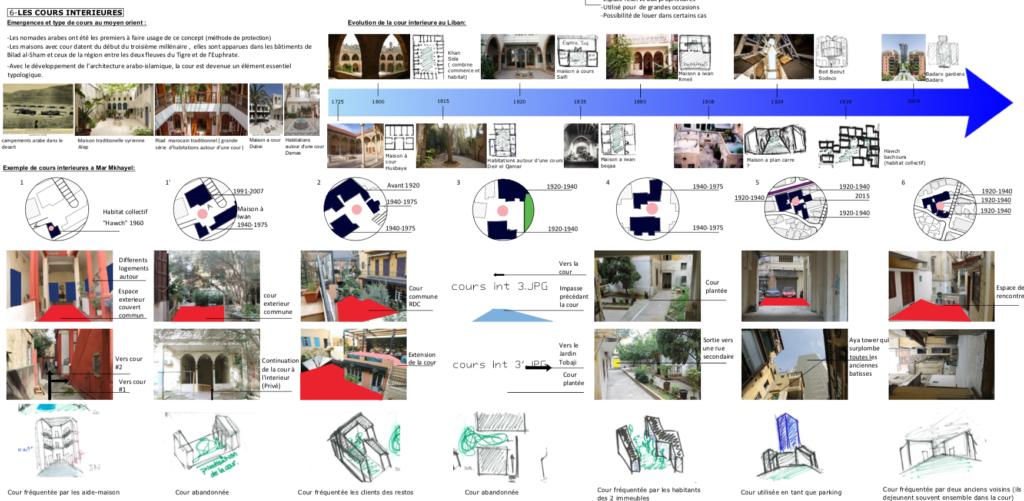23/09/2020 by Yara Ritz, Associate Researcher (Lebanon)
Elected general quarters of partying, the neighbourhoods of Gemmayze and Mar Mikhael are revealing examples: it is in these very dynamic districts that people, whether young or less young, Lebanese or foreigners, used to meet and hang out. As a symbol of Beirut’s cosmopolite life, they have nonetheless been the most impacted by the double explosion.
First, a thick and insidious grey smoke. General dizziness, guilty curiosity. Then, the rush to the windows. And the flood. A shallow breathing, an apocalypse and a deafening noise that took away innocent lives within a few seconds.
The capital is devastated. The Lebanese mourns not only its victims but also its heritage, heavily impacted by the two explosions that took place in Beirut’s harbour on August 4th, 2020.
Gemmayze and Mar Mikhael: an ode to colours and life
After the long years of civil war that troubled the country of Cedars from 1975 to 1990, party has become an essential element of Lebanese culture. The streets of Beirut perfectly testify to it.
Elected general quarters of partying, the neighbourhoods of Gemmayze and Mar Mikhael are revealing examples: it is in these very dynamic districts that people, whether young or less young, Lebanese or foreigners, used to meet and hang out. As a symbol of Beirut’s cosmopolite life, they have nonetheless been the most impacted by the double explosion.

Contrasts and memories
Intertwining the East and the West, the Gouraud and Armenia streets in Gemmayzeh used to represent a real architectural walk as well as a delicious journey in time. Walking in those animated streets was a delightful invitation to travel. One could easily find in this Bohemian and artistic neighbourhood bakeries with cute interior designs and generous shop windows, trendy bars and newspaper sellers, art galleries and small grocery stores. The district was thus a true laboratory of experimental ideas.
After the explosion, restoring and reconstructing should be faithful to the architectural heritage of the Lebanese capital. Real estate developers will probably try to take advantage of the situation to acquire buildings at a very low price to replace them with modern and functional buildings. This threat is all the more important as it is very present…
Architectural gems
A vividly colourful architectural language: here is what emanated from the historical buildings of Gemmayze and Mar Mikhael. Under an olive tree or the sloping roofs formed by the vine leaves, people would gather around to have lunch in the great and welcoming central years of the district.
These picturesque houses were provided with small secret gardens behind the buildings, free from chaos and noise. Here is the “three-arcade house”, typical of traditional Lebanese architecture, and more particularly the Beiruti. Yet many of these buildings, which are part of the national historical heritage, have been either destroyed, smashed down, or heavily damaged.

Reconstructing at stake
How can we think about reconstruction without speculation ?
Restoring and reconstructing should respect the city’s architectural heritage. Such process will be important since the emergency encapsulates many other districts. According to the Lebanese Ministry of Culture, 640 out of more than 8000 damaged buildings are historical ones; furthermore, 60 others are likely to collapse.
Among them are Beirut’s National Museum, the Sursock Museum, and the Archaeological Museum of the American University of Beirut, along with numerous religious sites and cultural places. UNESCO, in conjunction with the International alliance for the protection of heritage in conflict areas (ALIPH), promised to contribute to the rebuilding programs. Yet it requires that the necessary funds are raised as a first step. Real estate developers will probably try to take advantage of the situation to acquire buildings at a very low price to replace them with modern and functional buildings. This threat is all the more important as it is very present.
With winter coming, it is mandatory to fix the buildings and provide them with doors, windows, and isolation materials. Indeed, after the explosion, more than 300 000 people found themselves homeless.




85 comments
mexico pharmacy: cmqpharma.com – buying prescription drugs in mexico online
mexican pharmacy: cmq pharma mexican pharmacy – mexico pharmacies prescription drugs
http://foruspharma.com/# mexican rx online
https://canadapharmast.com/# northern pharmacy canada
the canadian pharmacy: canadian pharmacy sarasota – canada pharmacy reviews
buying prescription drugs in mexico online [url=https://foruspharma.com/#]mexico drug stores pharmacies[/url] mexico pharmacies prescription drugs
п»їbest mexican online pharmacies: mexico drug stores pharmacies – mexico pharmacy
india pharmacy: indian pharmacy – top online pharmacy india
top 10 online pharmacy in india [url=https://indiapharmast.com/#]india pharmacy[/url] top online pharmacy india
mexico drug stores pharmacies: mexican rx online – mexican pharmacy
https://canadapharmast.online/# legitimate canadian pharmacies
http://indiapharmast.com/# india pharmacy mail order
medicine in mexico pharmacies: mexican online pharmacies prescription drugs – medicine in mexico pharmacies
mexican online pharmacies prescription drugs [url=http://foruspharma.com/#]best online pharmacies in mexico[/url] buying from online mexican pharmacy
mexican rx online: mexico drug stores pharmacies – mexico drug stores pharmacies
reputable indian online pharmacy [url=http://indiapharmast.com/#]online pharmacy india[/url] online pharmacy india
india pharmacy: pharmacy website india – top 10 online pharmacy in india
http://foruspharma.com/# mexican border pharmacies shipping to usa
mexico pharmacy: mexican pharmacy – reputable mexican pharmacies online
https://foruspharma.com/# mexican pharmaceuticals online
legitimate canadian pharmacies: best canadian online pharmacy reviews – legit canadian pharmacy
canada pharmacy [url=http://canadapharmast.com/#]best canadian online pharmacy reviews[/url] drugs from canada
reputable mexican pharmacies online: mexico drug stores pharmacies – mexican drugstore online
п»їlegitimate online pharmacies india [url=http://indiapharmast.com/#]cheapest online pharmacy india[/url] Online medicine order
buying prescription drugs in mexico: best online pharmacies in mexico – buying prescription drugs in mexico
purple pharmacy mexico price list: mexican pharmaceuticals online – mexico pharmacies prescription drugs
reputable mexican pharmacies online: best online pharmacies in mexico – п»їbest mexican online pharmacies
Online medicine order: india pharmacy mail order – pharmacy website india
mexican rx online: mexican border pharmacies shipping to usa – mexican rx online
http://indiapharmast.com/# india online pharmacy
can i purchase clomid: can i order cheap clomid prices – can i buy cheap clomid without dr prescription
https://amoxildelivery.pro/# amoxicillin online purchase
buy cipro online canada [url=https://ciprodelivery.pro/#]cipro 500mg best prices[/url] п»їcipro generic
http://doxycyclinedelivery.pro/# doxycycline 100mg tablets cost
cipro [url=https://ciprodelivery.pro/#]buy cipro[/url] purchase cipro
п»їpaxlovid: paxlovid india – paxlovid covid
http://amoxildelivery.pro/# where can you get amoxicillin
https://ciprodelivery.pro/# ciprofloxacin mail online
https://paxloviddelivery.pro/# paxlovid price
clomid no prescription [url=https://clomiddelivery.pro/#]where to buy cheap clomid without prescription[/url] where to get cheap clomid without dr prescription
http://doxycyclinedelivery.pro/# doxycycline 100mg best buy
clomid without dr prescription [url=https://clomiddelivery.pro/#]buy generic clomid prices[/url] can i buy generic clomid without insurance
ciprofloxacin: ciprofloxacin generic price – buy cipro without rx
http://clomiddelivery.pro/# cost generic clomid for sale
cost of cheap clomid tablets: where can i buy clomid – cost of clomid without prescription
http://paxloviddelivery.pro/# paxlovid price
http://doxycyclinedelivery.pro/# doxycycline 20
paxlovid pharmacy [url=http://paxloviddelivery.pro/#]paxlovid buy[/url] paxlovid india
http://ciprodelivery.pro/# ciprofloxacin generic
doxycycline tablets cost [url=https://doxycyclinedelivery.pro/#]where to get doxycycline[/url] rx doxycycline 100mg
https://ciprodelivery.pro/# ciprofloxacin 500mg buy online
https://clomiddelivery.pro/# generic clomid for sale
can we buy amoxcillin 500mg on ebay without prescription: amoxicillin price without insurance – how to buy amoxicillin online
where buy generic clomid: can i order cheap clomid pill – where to get generic clomid pill
https://amoxildelivery.pro/# where can i buy amoxicillin over the counter uk
how to buy amoxycillin [url=https://amoxildelivery.pro/#]amoxicillin 500 mg online[/url] price for amoxicillin 875 mg
http://doxycyclinedelivery.pro/# doxycycline acne
paxlovid for sale [url=http://paxloviddelivery.pro/#]paxlovid for sale[/url] buy paxlovid online
http://paxloviddelivery.pro/# Paxlovid over the counter
http://doxycyclinedelivery.pro/# doxcyclene
amoxicillin 500mg capsules uk: amoxicillin 1000 mg capsule – where can you get amoxicillin
https://clomiddelivery.pro/# how can i get clomid tablets
https://ciprodelivery.pro/# purchase cipro
ciprofloxacin 500mg buy online [url=https://ciprodelivery.pro/#]buy cipro cheap[/url] purchase cipro
https://ciprodelivery.pro/# antibiotics cipro
https://clomiddelivery.pro/# how to get cheap clomid for sale
paxlovid pill [url=http://paxloviddelivery.pro/#]paxlovid for sale[/url] paxlovid cost without insurance
order amoxicillin 500mg: price for amoxicillin 875 mg – amoxicillin 500mg capsules
https://amoxildelivery.pro/# can you buy amoxicillin over the counter
http://amoxildelivery.pro/# buy amoxicillin from canada
http://amoxildelivery.pro/# amoxicillin 500mg prescription
doxycycline tablet [url=https://doxycyclinedelivery.pro/#]buy doxycycline canada[/url] doxycycline pharmacy singapore
http://amoxildelivery.pro/# order amoxicillin online no prescription
can i order clomid tablets [url=http://clomiddelivery.pro/#]cost generic clomid for sale[/url] where to buy generic clomid without dr prescription
how much is doxycycline: doxycycline 200 mg pill – doxycycline for sale over the counter
http://clomiddelivery.pro/# buy generic clomid no prescription
buying amoxicillin online: buying amoxicillin online – amoxicillin 500 mg tablet price
http://clomiddelivery.pro/# where buy generic clomid tablets
http://paxloviddelivery.pro/# Paxlovid buy online
paxlovid pill [url=https://paxloviddelivery.pro/#]paxlovid india[/url] paxlovid cost without insurance
http://clomiddelivery.pro/# where can i buy clomid pills
paxlovid for sale [url=http://paxloviddelivery.pro/#]paxlovid covid[/url] buy paxlovid online
https://paxloviddelivery.pro/# paxlovid india
http://doxycyclinedelivery.pro/# doxycycline for sale online uk
how to order doxycycline: doxycycline over the counter india – doxycycline hyclate 100 mg
where can i buy cipro online: ciprofloxacin mail online – cipro pharmacy
http://doxycyclinedelivery.pro/# doxycycline 100mg cap
buy cipro [url=https://ciprodelivery.pro/#]cipro online no prescription in the usa[/url] cipro
https://clomiddelivery.pro/# get cheap clomid price
doxycycline sale uk [url=http://doxycyclinedelivery.pro/#]doxycycline uk[/url] doxycycline 100 mg capsule
amoxicillin 500mg cost: buy amoxil – amoxicillin 500mg over the counter
how can i get clomid without rx: get cheap clomid online – can you buy cheap clomid without dr prescription
buy cipro online canada: buy cipro online canada – buy ciprofloxacin over the counter
amoxicillin price without insurance: amoxicillin 1000 mg capsule – generic for amoxicillin
buy cipro cheap: purchase cipro – buy cipro online canada